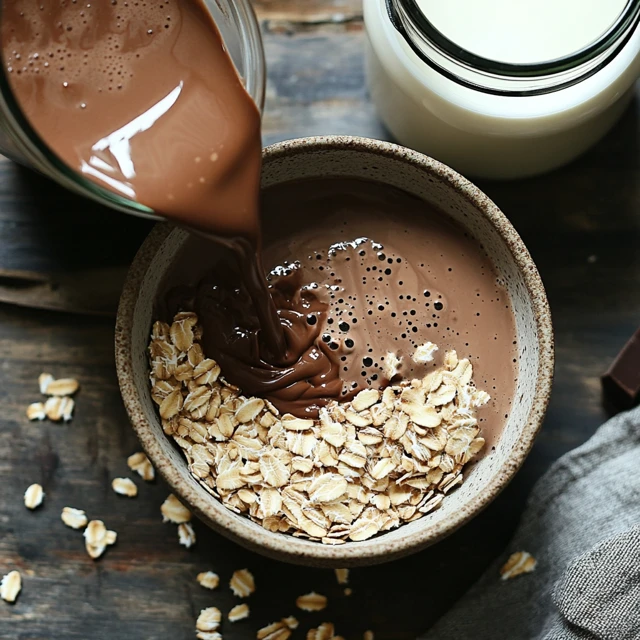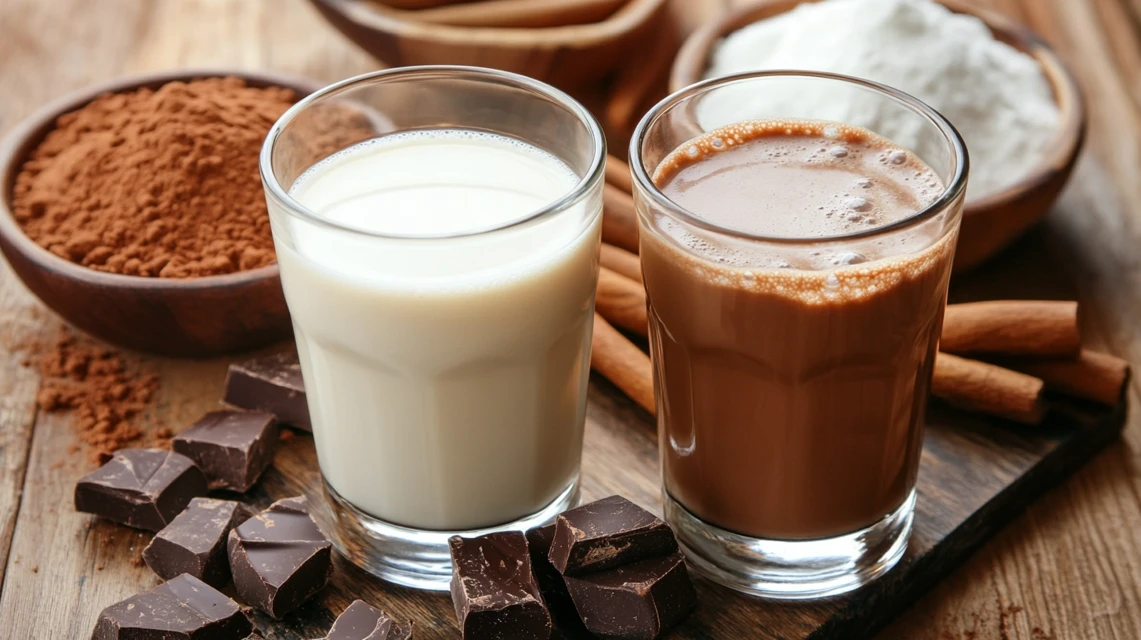Milk comes in many forms, and while most people think of plain white milk when they hear the word, the term can actually cover a broad range of beverages. Chocolate milk is just one example, but it raises the question: is chocolate milk still considered milk?
What Qualifies as Milk?
At its core, milk is defined as the liquid produced by mammals—such as cows, goats, or sheep—for nourishing their young. Over time, the term has expanded to include plant-based alternatives like almond milk, soy milk, and oat milk, which mimic the consistency and nutritional profile of traditional dairy milk.
Regardless of the source, all milk serves as a base for beverages like chocolate milk, making it fair to consider chocolate milk a variant rather than a completely separate category. In other words, as long as the drink’s primary ingredient is milk—whether it’s cow’s milk or a plant-based alternative—it can still be classified as milk.
check out this https://eassyrecipes.com/chocolate-milk/
How Chocolate Milk Differs from Plain Milk
While plain milk is typically free of added flavors or sweeteners, chocolate milk includes ingredients like cocoa and sugar, giving it its distinct taste. This addition of flavoring, however, doesn’t mean it’s no longer milk. Instead, it simply transforms plain milk into a flavored variety. Think of it as milk with a twist rather than a completely different beverage.
Chocolate milk often has a similar creamy consistency and delivers many of the same nutrients as plain milk, such as calcium and vitamin D. This similarity in composition is another reason why chocolate milk is still considered milk, despite its additional ingredients.
The Role of Additives in Chocolate Milk
Additives like cocoa and sugar are what set chocolate milk apart from its plain counterpart. Cocoa powder gives the milk its rich chocolatey taste, while sweeteners balance the bitterness of cocoa, creating the smooth, enjoyable drink people love.
Other common additives may include:
- Stabilizers: These help maintain the creamy texture and prevent the cocoa from settling at the bottom.
- Vitamins and Minerals: Many brands fortify their chocolate milk with extra nutrients to enhance its health benefits.
While these additives change the flavor profile, they don’t fundamentally alter the drink’s classification as milk. Instead, they simply add variety to the basic concept of milk, making chocolate milk an extension of the original rather than a departure from it.
Nutritional Comparison

When considering whether chocolate milk is still milk, it’s helpful to look at the nutrition. Many of the nutrients found in plain milk remain intact in chocolate milk, even though the added flavors and sugars introduce some differences.
Nutrients Found in Regular Milk
Plain milk is a nutritional powerhouse, offering:
- Calcium: Essential for strong bones and teeth.
- Protein: Helps build and repair tissues.
- Vitamin D: Supports bone health and immune function.
- Potassium: Helps regulate blood pressure.
These nutrients make milk an important part of a balanced diet, and they are not lost when the milk is turned into chocolate milk.
Nutritional Differences in Chocolate Milk
Chocolate milk contains the same core nutrients as plain milk, but it also has:
- Higher Sugar Content: The added cocoa and sweeteners increase the sugar levels, making chocolate milk more calorie-dense.
- Added Flavors: While these don’t necessarily add nutritional value, they make the milk more appealing to those who might not enjoy plain milk.
In many cases, manufacturers fortify chocolate milk with extra vitamins and minerals to offset any perceived downsides from the added sugar. This means that chocolate milk can still offer the benefits of plain milk, just with a sweeter taste.
The Impact of Added Sugar
The main difference in nutrition between plain and chocolate milk lies in the added sugar. While plain milk has naturally occurring lactose (milk sugar), chocolate milk includes additional sweeteners. This can be a drawback for those watching their sugar intake, but it’s worth noting that the overall nutritional profile of chocolate milk still closely resembles that of plain milk.
Key Considerations:
- Moderation Matters: Enjoying chocolate milk in moderation can help balance its added sugar content.
- Enhanced Palatability: The added sugar makes milk more enjoyable for some people, encouraging them to consume milk’s beneficial nutrients.
Ultimately, the added sugar in chocolate milk doesn’t disqualify it from being considered milk. Instead, it highlights the importance of enjoying it mindfully as part of a balanced diet.
The Debate: Milk or a Separate Beverage?
Industry Standards and Labeling
When it comes to whether chocolate milk is milk or a separate drink, industry standards and labeling play a big role. Dairy producers and regulatory agencies define what counts as milk. In most cases, chocolate milk falls into the “flavored milk” category. This means they treat it as milk with added flavoring, not as a completely different drink.
Key Points on Industry Standards:
- Flavored Milk Classification: Chocolate milk usually falls into the same category as other flavored milks, such as strawberry or vanilla, rather than forming its own unique class of beverage.
- Consistent Labeling Practices: Cartons and bottles say “chocolate milk” on the label, showing that milk is the main ingredient.
- Regulatory Oversight: Agencies such as the FDA in the United States oversee how products like chocolate milk are labeled. This ensures that consumers understand it is milk with added ingredients, not a different type of drink entirely.
This consistency in standards and labeling helps reinforce the idea that chocolate milk remains milk, albeit a flavored variety.
check out this https://eassyrecipes.com/chocolate-milk/
Consumer Perception and Marketing
Consumer perception, shaped heavily by marketing efforts, also influences how people view chocolate milk. Many consumers still see it as milk, while others treat it as a separate, indulgent treat. Marketing campaigns frequently focus on chocolate milk’s taste, convenience, and nutritional value, blurring the line between milk as a staple and chocolate milk as a treat.
Marketing Strategies:
- Appealing to Both Kids and Adults: Ads often highlight chocolate milk as a fun, flavorful alternative to plain milk.
- Nutritional Messaging: Many brands promote chocolate milk as a source of calcium, protein, and vitamins, reinforcing its identity as milk.
- Convenience and Indulgence: Campaigns portray chocolate milk as both a quick snack and a dessert-like beverage, which can lead consumers to see it as more than just milk.
Despite these varying perceptions, marketing efforts usually emphasize that chocolate milk starts as plain milk, keeping it firmly rooted in the milk category for most consumers.
The Health Perspective

From a health standpoint, chocolate milk retains many of the benefits of plain milk, which supports the argument that it is still milk. However, it also has added sugars and calories, prompting some to view it as a less healthy alternative. This dual perspective contributes to the ongoing debate.
Health Benefits:
- Calcium and Vitamin D: Chocolate milk provides the same bone-strengthening nutrients as plain milk.
- Protein for Muscle Repair: It’s a good source of protein, making it suitable for post-workout recovery.
- Hydration and Electrolytes: Chocolate milk can help replenish fluids and electrolytes after exercise, similar to sports drinks.
Health Concerns:
- Added Sugars: The additional sugar in chocolate milk contributes extra calories, which can be a concern for those watching their intake.
- Moderation Matters: Experts recommend enjoying chocolate milk in moderation as part of a balanced diet. Choosing low-sugar options or controlling portion sizes can help offset these concerns.
Overall, the health perspective supports the idea that chocolate milk is still milk but encourages consumers to consider its sugar content and enjoy it responsibly.
check out this https://eassyrecipes.com/chocolate-milk/
FAQs About Chocolate Milk as Milk
Is Chocolate Considered Milk?
Is Chocolate Milk Still Considered Milk? Chocolate, by itself, is not milk. People make chocolate from roasted and ground cocoa beans, often mixing them with sugar, cocoa butter, and sometimes milk powder, depending on the type. While chocolate is a common ingredient in many dairy-based drinks and desserts, it doesn’t fit the definition of milk. Milk is a liquid that mammals produce (or comes from plant-based sources), and people drink it or use it in cooking and baking. Chocolate milk, however, is milk flavored with chocolate and sweeteners. So, chocolate alone isn’t milk, but when you mix it with milk, it becomes a flavored milk product.
Is Chocolate Milk the Same as Regular Milk?
Chocolate milk and regular milk share the same foundational ingredient—milk—but they differ due to added flavors and sugars. Regular milk is plain and unflavored, often available in varying fat contents such as whole milk, 2%, 1%, or fat-free. Chocolate milk, however, contains additional cocoa or chocolate syrup, along with a sweetener, to give it a rich, chocolaty taste. While they provide similar core nutrients like calcium, protein, and vitamin D, chocolate milk also has extra calories and sugars.
Is Chocolate Milk Just Expired Milk?
No, chocolate milk is not made from expired or “bad” milk. This is a common misconception. The milk used to make chocolate milk meets the same quality standards as regular milk. It goes through the same pasteurization process to ensure safety and freshness. Adding cocoa, sweeteners, and other flavorings doesn’t change the fact that it starts as high-quality milk. The idea that chocolate milk hides spoiled milk is just a myth. Instead, producers make and package it just like plain milk, following strict hygiene and safety measures.
Is Fairlife Chocolate Milk Actually Milk?
Yes, Fairlife chocolate milk is milk. Fairlife uses a special process to add more protein and cut down on sugar. This process changes what’s in the milk but doesn’t make it stop being milk. Fairlife milk comes from cows, just like regular milk, and keeps all the key features of milk, like its creamy feel, nutrients, and dairy source. The chocolate kind has cocoa and sweeteners for flavor, but it’s still milk. If you want milk with more protein and less sugar, Fairlife chocolate milk is a good choice.
Conclusion
Chocolate milk remains a beloved beverage, enjoyed by people of all ages for its creamy texture and sweet taste. Despite its added flavors and sugars, chocolate milk is still milk at its core. It retains the key nutrients of plain milk, including calcium, protein, and vitamin D, making it more than just a treat. The distinction between chocolate milk and plain milk lies in the flavoring, but not in the fundamental nature of the drink. For those who choose it, chocolate milk offers a delicious way to enjoy the benefits of milk while satisfying a sweet craving.

